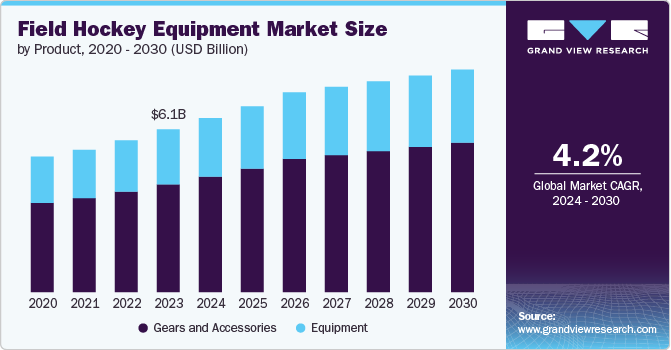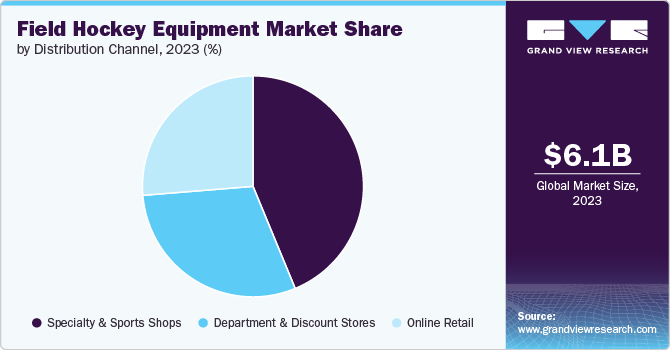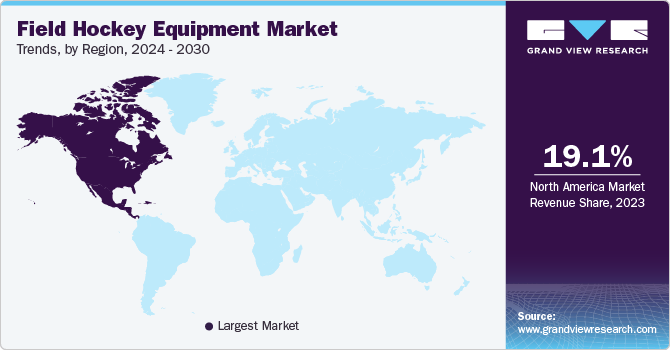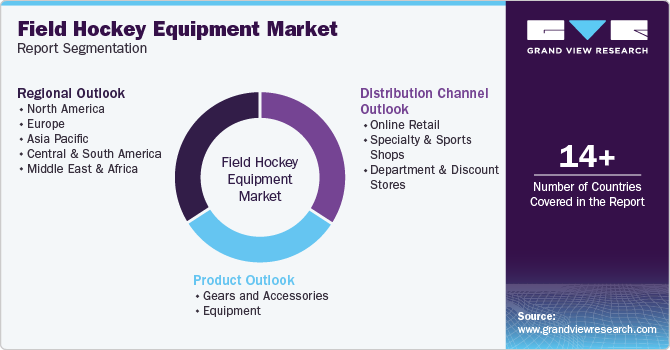- Home
- »
- Clothing, Footwear & Accessories
- »
-
Field Hockey Equipment Market Size And Share Report 2030GVR Report cover
![Field Hockey Equipment Market Size, Share & Trends Report]()
Field Hockey Equipment Market Size, Share & Trends Analysis Report By Product (Gears and Accessories, Equipment), By Distribution Channel (Online Houses, Specialty & Sports Shops), By Region, And Segment Forecasts, 2024 - 2030
- Report ID: GVR-4-68040-410-4
- Number of Report Pages: 100
- Format: PDF, Horizon Databook
- Historical Range: 2018 - 2023
- Forecast Period: 2024 - 2030
- Industry: Consumer Goods
Field Hockey Equipment Market Trends
The global field hockey equipment market size was estimated at USD 6.10 billion in 2023 and is expected to grow at a CAGR of 4.2% from 2024 to 2030. The surge in participation rates across various age groups is one of the primary growth drivers for the field hockey equipment market. Schools and colleges are increasingly incorporating field hockey into their sports programs, attracting young talent. In addition, grassroots initiatives supported by local associations are bringing the sport to underserved populations, further enhancing participation.

Innovative technology plays a crucial role in crafting high-performance field hockey gear. The introduction of lightweight materials, advanced manufacturing techniques, and ergonomic designs has revolutionized the quality of field hockey sticks and protective equipment. Enhanced stick designs allow for better control and precision, while protective gear provides superior safety without compromising mobility. These advancements not only attract seasoned players looking to enhance their game but also stimulate interest among new entrants.
Government bodies and sporting organizations worldwide are heavily investing in building and upgrading field hockey infrastructure, including pitches, training centers, and academies. The development of well-equipped facilities not only catalyzes local and international competitions but also attracts younger players, creating a sustainable future for the sport.
Field hockey's inclusion in major international sporting events such as the Olympics, the Commonwealth Games, and the FIH Hockey World Cup boosts its global visibility, leading to increased participation and demand for equipment. Nowadays, there is growing youth involvement in field hockey, especially in schools and colleges, driven by increased emphasis on sports in education. This participation fuels the demand for entry-level and advanced equipment. Innovations in equipment, such as lightweight composite sticks, improved grip technology, and advanced protective gear, attract players seeking better performance and safety.
With growing awareness of environmental issues, manufacturers are focusing on sustainable materials and eco-friendly production processes for field hockey equipment. Biodegradable and recyclable materials are being increasingly used. Moreover, there is a growing trend of customizing field hockey sticks and gear with personal branding, colors, and logos, particularly among professional players and teams.
Increased sponsorship opportunities and brand endorsements, particularly in high-profile tournaments and leagues, offer lucrative prospects for equipment manufacturers and retailers. Partnerships with sports organizations, schools, and clubs to provide equipment or sponsor events can help brands increase their visibility and drive sales.
Product Insights
Gears and accessories accounted for a share of 66.31% of the global revenue in 2023. The gears and accessories segment includes a wide variety of products such as protective gear (helmets, gloves, shin guards, mouth guards), bags, grips, goalkeeping equipment, training aids, and maintenance tools. This diversity ensures that players require multiple items from this segment, whether they are beginners or professionals. Protective gear is essential for player safety, which is a priority at all levels of play. With increasing awareness of injury prevention, players and teams are investing more in high-quality protective equipment. Many gears and accessories can be customized or personalized, such as choosing specific colors, designs, or custom fittings for items such as mouthguards and gloves. This trend has driven higher sales, especially among players who seek to express their individuality or team spirit.
The field hockey equipment market is expected to grow at a CAGR of 3.8% from 2024 to 2030. Continuous innovation in materials and design has led to the development of advanced field hockey sticks, such as those made from composite materials (e.g., carbon fiber, fiberglass) that offer better control, power, and durability. These innovations attract players looking for improved performance, driving growth in the segment. Enhanced ball designs that offer better aerodynamics and consistency in play, along with improved goalposts that are more durable and easier to transport, also contribute to the segment’s growth.
Distribution Channel Insights
The sales of field hockey equipment through the specialty & sports shop segment accounted for a revenue share of 43.8% in 2023. Specialty and sports shops are often staffed by experts who have in-depth knowledge of field hockey equipment. They can provide personalized advice and recommendations based on a player's skill level, playing style, and specific needs. This level of expertise is highly valued by players, especially those who are serious about the sport, leading them to prefer purchasing from these outlets. These shops typically offer a comprehensive selection of high-quality and specialized field hockey equipment, including top brands and the latest models. They cater to both amateur and professional players who are looking for premium products, driving higher sales and revenue in this segment.

The sales of field hockey equipment through online retail are expected to grow at a CAGR of 4.8% from 2024 to 2030. Online retail provides access to a broader range of products. Retailers often showcase an extensive inventory that caters to various skill levels, preferences, and budgets. For niche markets like field hockey, this means players can find specialized gear—from sticks and balls to protective equipment and apparel—more easily. Many online retailers augment their sales through engaging content, such as how-to videos, blogs on techniques, and community forums. These resources help educate consumers about the right equipment for their needs while fostering a sense of community within the field hockey ecosystem.
Regional Insights
The field hockey equipment market in North America captured a revenue share of over 19.12% in the market. The expansion of local field hockey clubs and amateur leagues in North America has created more opportunities for people to participate in the sport. This has led to an increased demand for high-quality equipment. The expansion of local field hockey clubs and amateur leagues in North America has created more opportunities for people to participate in the sport. This has led to an increased demand for high-quality equipment. Advances in manufacturing technologies have led to the development of lighter, more durable, and more responsive equipment. Innovations in material science, such as carbon fiber and composite materials, contribute to improved player performance and enjoyment of the game.

U.S. Field Hockey Equipment Market Trends
The field hockey equipment market in the U.S. is projected to grow at a CAGR of 4.2% from 2024 to 2030.Field hockey is particularly popular among female athletes in the U.S., with many high schools and colleges offering it as a competitive sport. The NCAA (National Collegiate Athletic Association) supports numerous women's field hockey teams, driving consistent demand for equipment. There is a growing emphasis on health, fitness, and the benefits of team sports like field hockey. This trend is encouraging more youth and adults to take up the sport, driving sales of equipment across various categories.
Europe Field Hockey Equipment Market Trends
The field hockey equipment market in Europe is expected to grow at a CAGR of 4.3% from 2024 to 2030. Europe is home to some of the most competitive domestic field hockey leagues, such as the Dutch Hoofdklasse, the English Premier League, and the Belgian Hockey League. These leagues attract top talent from around the world and maintain a high level of spectator interest, driving demand for quality equipment. Major international tournaments such as the European Hockey Championships and the Hockey World Cup, often hosted in European countries, further boost the sport’s visibility and popularity. These events lead to spikes in equipment sales, especially among young players inspired by elite-level competition.
European players and manufacturers are at the forefront of developing and adopting new technologies in field hockey sticks, including advanced composites for enhanced strength, control, and lightweight properties. These innovations are crucial in a market that values high-performance gear.
Asia Pacific Field Hockey Equipment Market Trends
The field hockey equipment market in Asia Pacific is expected to witness a CAGR of 4.5% from 2024 to 2030. Governments in the Asia Pacific region, particularly in India and Malaysia, are investing in the development of field hockey through various initiatives, including the establishment of training academies, the organization of national and international tournaments, and funding for grassroots programs. Improved infrastructure, such as the construction of modern hockey stadiums and training facilities, is also playing a role in the growth of the sport. This has a direct impact on the demand for field hockey equipment, as better facilities attract more participants.
Key Field Hockey Equipment Company Insights
The field hockey equipment market is indeed characterized by a diverse range of companies, from small local providers to large multinational firms. These companies are employing various strategies to gain a competitive edge and capture market share. Companies are expanding their product portfolios to include a wide variety of field hockey equipment, such as sticks, balls, protective gear, apparel, footwear, and accessories. By offering a comprehensive range of products, companies can cater to the diverse needs of different customer segments, from beginners to professional players.
Key Field Hockey Equipment Companies:
The following are the leading companies in the field hockey equipment market. These companies collectively hold the largest market share and dictate industry trends.
- Adidas AG
- Grays Hockey
- Gryphon Hockey Ltd
- BAUER HOCKEY, LLC
- STX
- Kookaburra Sport Pty Ltd
- Mazon Hockey
- Dita Hockey
- Voodoo Hockey
- OBO Hockey
Recent Developments
-
In May 2024, the Professional Women’s Hockey League (PWHL) announced a new partnership with Bauer Hockey, naming the esteemed hockey equipment and apparel brand as the Official Jersey Partner for the 2024-25 season. This expanded collaboration builds on Bauer's current involvement with the league, which focuses on their 'Everything for the Girls' initiative, strengthening their role as both a key league partner and equipment supplier.
-
In October 2023, CCM Hockey, a top designer, manufacturer, and marketer of hockey equipment, is pleased to announce its new role as a full equipment supplier and official partner of the Professional Women’s Hockey League (PWHL). CCM is excited to support the league by providing each player with high-performance equipment designed to enhance their game.
Field Hockey Equipment Market Report Scope
Report Attribute
Details
Market size value in 2024
USD 6.52 billion
Revenue forecast in 2030
USD 8.34 billion
Growth rate
CAGR of 4.2% from 2024 to 2030
Actuals
2018 - 2023
Forecast period
2024 - 2030
Quantitative units
Revenue in USD million/billion, and CAGR from 2024 to 2030
Report coverage
Revenue forecast, company ranking, competitive landscape, growth factors, and trends
Segments covered
Product, distribution channel, region
Regional scope
North America; Europe; Asia Pacific; Central & South America; Middle East & Africa
Country scope
U.S.; Canada; Mexico; Germany; France; Spain; Netherlands, UK; Belgium; Ireland; Italy; China; Japan; India; South Korea; Australia & New Zealand; Argentina; Brazil; South Africa
Key companies profiled
Adidas AG; Grays Hockey; Gryphon Hockey Ltd; BAUER HOCKEY, LLC; STX; Kookaburra Sport Pty Ltd; Mazon Hockey; Dita Hockey; Voodoo Hockey; OBO Hockey
Customization scope
Free Report customization (equivalent up to 8 analysts working days) with purchase. Addition or alteration to country, regional & segment scope.
Pricing and purchase options
Avail customized purchase options to meet your exact research needs. Explore purchase options.
Global Field Hockey Equipment Market Segmentation
This report forecasts revenue growth at the global, regional, and country levels and provides an analysis of the latest industry trends and opportunities in each of the sub-segments from 2018 to 2030. For the purpose of this study, Grand View Research has segmented the global field hockey equipment market report based on product, distribution channel, and region:

-
Product Outlook (Revenue, USD Million, 2018 - 2030)
-
Gears and Accessories
-
Apparel
-
Footwear
-
Masks & Goggles
-
Field Hockey Gloves
-
Mouthguards
-
Shinguards & Rashguards
-
Other Accessories
-
-
Equipment
-
Field Hockey Stick
-
Field Hockey Ball
-
-
-
Distribution Channel Outlook (Revenue, USD Million, 2018 - 2030)
-
Online Retail
-
Specialty & Sports Shops
-
Department & Discount Stores
-
-
Regional Outlook (Revenue, USD Million, 2018 - 2030)
-
North America
-
U.S.
-
Canada
-
Mexico
-
-
Europe
-
Netherlands
-
Germany
-
Belgium
-
Spain
-
Ireland
-
France
-
UK
-
Italy
-
-
Asia Pacific
-
China
-
Japan
-
India
-
Australia & New Zealand
-
South Korea
-
-
Central & South America
-
Brazil
-
Argentina
-
-
Middle East & Africa
-
South Africa
-
-
Frequently Asked Questions About This Report
b. The global field hockey equipment market size was estimated at USD 6.10 billion in 2023 and is expected to reach USD 6.52 billion in 2024.
b. The global field hockey equipment market is expected to grow at a compounded growth rate of 4.2% from 2024 to 2030 to reach USD 8.34 billion by 2030.
b. The gear & accessories segment dominated the field hockey equipment market with a share of 66.31% in 2023. Protective gear is essential for player safety, which is a priority at all levels of play. With increasing awareness of injury prevention, players and teams are investing more in high-quality protective equipment. Many gears and accessories can be customized or personalized, such as choosing specific colors, designs, or custom fittings for items like mouthguards and gloves.
b. Some key players operating in the field hockey equipment market include Adidas AG; Grays Hockey; Gryphon Hockey Ltd; BAUER HOCKEY, LLC; STX; Kookaburra Sport Pty Ltd; and Mazon Hockey
b. Key factors that are driving the market growth include a surge in participation rates across various age groups. Additionally, grassroots initiatives supported by local associations are bringing the sport to underserved populations, further enhancing participation.
Share this report with your colleague or friend.
![gvr icn]()
NEED A CUSTOM REPORT?
We can customize every report - free of charge - including purchasing stand-alone sections or country-level reports, as well as offer affordable discounts for start-ups & universities. Contact us now
![Certified Icon]()
We are GDPR and CCPA compliant! Your transaction & personal information is safe and secure. For more details, please read our privacy policy.
We are committed towards customer satisfaction, and quality service.
"The quality of research they have done for us has been excellent."





